“I Felt I Was Actually Inside the Movie” An Exploratory Study into Children’s Views of Staging a Physically Active Experience, with Implications for Future Interventions
Abstract
:1. Introduction
2. Materials and Methods
2.1. Participants
2.2. Protocol
2.3. Materials
2.3.1. Video 1—The Jellyfish Jump Physically Active Experience
2.3.2. Video 2—The Lightning’s Laps Physically Active Experience
2.3.3. Video 3—The Andy’s Coming Physically Active Experience
2.4. Data Analysis
3. Results and Discussion
3.1. Theme 1—(E)aesthetics
3.2. Theme 2—Escapist
3.3. Theme 3—Educate
3.4. Theme 4—Entertainment
3.5. Negative Comments/Areas of Improvements
3.6. Limitations and Future Directions
4. Conclusions
Author Contributions
Funding
Institutional Review Board Statement
Informed Consent Statement
Data Availability Statement
Conflicts of Interest
Appendix A
Appendix A.1. Pseudonym Information
| Group 1 | Group 2 | Group 3 | Group 4 |
| Thomas (boy) Daniel (boy) Mia (girl) Sarah (girl) | Chris (boy) Ava (girl) Clara (girl) Lucas (boy) | Liam (boy) Emma (girl) Noah (boy) James (boy) Ben (boy) | Lucy (girl) Isabella (girl) Arlo (boy) Sophie (girl) |
Appendix A.2. Video Links
- (1)
- https://www.dropbox.com/s/da63sw2bkhsv045/Jellyfish%20Jump.mp4?dl=0 (accessed on 14 February 2023)
- (2)
- https://www.dropbox.com/s/8x5t7aukeouexa2/Lightnings%20laps%20.mp4?dl=0 (accessed on 14 February 2023)
- (3)
- https://www.dropbox.com/s/d0jbi4o251cq3my/Andy%27s%20coming%20.mp4?dl=0 (accessed 14 February 2023)
References
- World Health Organization. 2021. Available online: https://www.who.int/news-room/fact-sheets/detail/physical-activity (accessed on 14 February 2023).
- Troiano, R.P.; Berrigan, D.; Dodd, K.W.; Masse, L.C.; Tilert, T.; McDowell, M. Physical activity in the United States measured by accelerometer. Med. Sci. Sport. Exerc. 2008, 40, 181. [Google Scholar] [CrossRef] [PubMed]
- Ozemek, C.; Lavie, C.J.; Rognmo, Ø. Global physical activity levels-Need for intervention. Prog. Cardiovasc. Dis. 2019, 62, 102–107. [Google Scholar] [CrossRef] [PubMed]
- Hills, A.P.; Dengel, D.R.; Lubans, D.R. Supporting public health priorZities: Recommendations for physical education and physical activity promotion in schools. Prog. Cardiovasc. Dis. 2015, 57, 368–374. [Google Scholar] [CrossRef] [PubMed] [Green Version]
- Lakshman, R.; Paes, V.M.; Hesketh, K.; O’Malley, C.; Moore, H.; Ong, K.; Summerbell, C. Protocol for systematic reviews of determinants/correlates of obesity-related dietary and physical activity behaviors in young children (preschool 0 to 6 years): Evidence mapping and syntheses. Syst. Rev. 2013, 2, 28. [Google Scholar] [CrossRef] [PubMed] [Green Version]
- Dishman, R.K.; Sallis, J.F.; Orenstein, D.R. The determinants of physical activity and exercise. Public Health Rep. 1985, 100, 158. [Google Scholar]
- Gallagher, K.A.S. The Relationship between Affective Response to Exercise and Activity Level among Children. Doctoral Dissertation, University of Kansas, Lawrence, KS, USA, 2010. [Google Scholar]
- Kwan, B.M.; Bryan, A.D. Affective response to exercise as a component of exercise motivation: Attitudes, norms, self-efficacy, and temporal stability of intentions. Psychol. Sport Exerc. 2010, 11, 71–79. [Google Scholar] [CrossRef] [Green Version]
- Haas, P.; Yang, C.H.; Dunton, G.F. Associations Between Physical Activity Enjoyment and Age-Related Decline in Physical Activity in Children—Results from a Longitudinal within-Person Study. J. Sport Exerc. Psychol. 2021, 43, 205–214. [Google Scholar] [CrossRef]
- Piggin, J. What is physical activity? A holistic definition for teachers, researchers and policy makers. Front. Sport. Act. Living 2020, 2, 72. [Google Scholar] [CrossRef]
- Budzynski-Seymour, E.; Jones, M.; Steele, J. ‘A Physically Active Experience’: Setting the Stage for a New Approach to Engage Children in Physical Activity Using Themed Entertainment Experiences. Sport. Med. 2022, 52, 2579–2591. [Google Scholar] [CrossRef]
- Pine, B.J.; Gilmore, J.H. Welcome to the experience economy. Harv. Bus. Rev. 1998, 76, 97–105. [Google Scholar]
- Chytry, J. Walt Disney and the creation of emotional environments: Interpreting Walt Disney’s oeuvre from the Disney studios to Disneyland, CalArts, and the Experimental Prototype Community of Tomorrow (EPCOT). Rethink. Hist. 2012, 16, 259–278. [Google Scholar] [CrossRef]
- Csikszentmihalyi, M.; Robinson, R.E. The Art of Seeing: An Interpretation of the Aesthetic Encounter; Getty Publications: Santa Monica, CA, USA, 1990. [Google Scholar]
- Shen, F.; Han, J. Effectiveness of entertainment education in communicating health information: A systematic review. Asian J. Commun. 2014, 24, 605–616. [Google Scholar] [CrossRef]
- Baranowski, T.; Buday, R.; Thompson, D.I.; Baranowski, J. Playing for real: Video games and stories for health-related behavior change. Am. J. Prev. Med. 2008, 34, 74–82. [Google Scholar] [CrossRef] [PubMed]
- Laamarti, F.; Eid, M.; El Saddik, A. An overview of serious games. Int. J. Comput. Games Technol. 2014, 2014, 358152. [Google Scholar] [CrossRef] [Green Version]
- Fischer, P.M.; Schwartz, M.P.; Richards, J.W.; Goldstein, A.O.; Rojas, T.H. Brand logo recognition by children aged 3 to 6 years: Mickey Mouse and Old Joe the Camel. Jama 1991, 266, 3145–3148. [Google Scholar] [CrossRef]
- Sandlin, J.A.; Garlen, J.C. (Eds.) Disney, Culture, and Curriculum; Routledge: Oxfordshire, UK, 2016. [Google Scholar]
- Giroux, H.A. Animating youth: The Disneyfication of children’s culture. Social. Rev. 1994, 24, 23. [Google Scholar]
- Padilla-Walker, L.M.; Coyne, S.M.; Fraser, A.M.; Stockdale, L.A. Is Disney the nicest place on earth? A content analysis of prosocial behavior in animated Disney films. J. Commun. 2013, 63, 393–412. [Google Scholar] [CrossRef]
- de Leeuw, R.N.; van der Laan, C.A. Helping behavior in Disney animated movies and children’s helping behavior in the Netherlands. J. Child. Media 2018, 12, 159–174. [Google Scholar] [CrossRef]
- Hulley, A.; Bentley, N.; Clough, C.; Fishlock, A.; Morrell, F.; O’Brien, J.; Radmore, J. Active and passive commuting to school: Influences on affect in primary school children. Res. Q. Exerc. Sport 2008, 79, 525–534. [Google Scholar] [CrossRef]
- Gautam, S.; Bulley, A.; von Hippel, W.; Suddendorf, T. Affective forecasting bias in preschool children. J. Exp. Child Psychol. 2017, 159, 175–184. [Google Scholar] [CrossRef]
- Braun, V.; Clarke, V.; Weate, P. Using thematic analysis in sport and exercise research. In Routledge Handbook of Qualitative Research in Sport and Exercise; Routledge: Oxfordshire, UK, 2016; pp. 213–227. [Google Scholar]
- Pawlowski, C.S.; Andersen, H.B.; Troelsen, J.; Schipperijn, J. Children’s physical activity behavior during school recess: A pilot study using GPS, accelerometer, participant observation, and go-along interview. PLoS ONE 2016, 11, e0148786. [Google Scholar] [CrossRef] [PubMed] [Green Version]
- Karageorghis, C.I.; Priest, D.L. Music in the exercise domain: A review and synthesis (Part I). Int. Rev. Sport Exerc. Psychol. 2012, 5, 44–66. [Google Scholar] [CrossRef] [Green Version]
- Budzynski-Seymour, E.; Jones, M.; Steele, J. Can Earth’s mightiest heroes help children be physically active? Exploring the immersive qualities of Les Mills’ and Marvel’s “Move Like the Avengers” video. Int. J. Environ. Res. Public Health 2021, 18, 7184. [Google Scholar] [CrossRef] [PubMed]
- Vazou, S.; Mischo, A.; Ladwig, M.A.; Ekkekakis, P.; Welk, G. Psychologically informed physical fitness practice in schools: A field experiment. Psychol. Sport Exerc. 2019, 40, 143–151. [Google Scholar] [CrossRef] [Green Version]
- Moyer-Gusé, E. Toward a theory of entertainment persuasion: Explaining the persuasive effects of entertainment-education messages. Commun. Theory 2008, 18, 407–425. [Google Scholar] [CrossRef]
- Budzynski-Seymour, E.; Jones, M.; Steele, J. The influence of Public Health England’s Change4Life Disney branded 10-minute shake ups on children’s post activity affective response. Commun. Kinesiol. 2021, 1. [Google Scholar] [CrossRef]
- Public Health England. 2019. Available online: https://sportengland-production-files.s3.eu-west-2.amazonaws.com/s3fs-public/20190701-public-health-england-disney-uk-and-sport-england-launch-national-change4life-10-minute-shake-up-campaign.pdf (accessed on 14 February 2023).
- Pine, B.J.; Gilmore, J.H. The Experience Economy; Harvard Business Press: Cambridge, MA, USA, 2011. [Google Scholar]
- Ladwig, M.A.; Vazou, S.; Ekkekakis, P. “My best memory is when I was done with it”: PE memories are associated with adult sedentary behavior. Transl. J. Am. Coll. Sport. Med. 2018, 3, 119–129. [Google Scholar] [CrossRef]
- Hopple, C.J. Top 10 reasons why children find physical activity to be fun. Strategies 2018, 31, 40–47. [Google Scholar] [CrossRef]
- Miller, A.; Christensen, E.M.; Eather, N.; Sproule, J.; Annis-Brown, L.; Lubans, D.R. The PLUNGE randomized controlled trial: Evaluation of a games-based physical activity professional learning program in primary school physical education. Prev. Med. 2015, 74, 1–8. [Google Scholar] [CrossRef] [Green Version]
- Malone, T.W. What makes things fun to learn? Heuristics for designing instructional computer games. In Proceedings of the 3rd ACM SIGSMALL Symposium and the First SIGPC Symposium on Small Systems; ACM: New York, NY, USA, 1980; pp. 162–169. [Google Scholar]
- Huhman, M.; Potter, L.D.; Wong, F.L.; Banspach, S.W.; Duke, J.C.; Heitzler, C.D. Effects of a mass media campaign to increase physical activity among children: Year-1 results of the VERB campaign. Pediatrics 2005, 116, e277–e284. [Google Scholar] [CrossRef] [Green Version]
- Pine, B.J.; Gilmore, J.H. The experience economy: Past, present and future. In Handbook on the Experience Economy; Edward Elgar Publishing: Cheltenham, UK, 2013. [Google Scholar]
- Dyrlund, A.K.; Wininger, S.R. The effects of music preference and exercise intensity on psychological variables. J. Music Ther. 2008, 45, 114–134. [Google Scholar] [CrossRef] [PubMed]
- Stratton, G.; Mullan, E. The effect of multicolor playground markings on children’s physical activity level during recess. Prev. Med. 2005, 41, 828–833. [Google Scholar] [CrossRef] [PubMed] [Green Version]
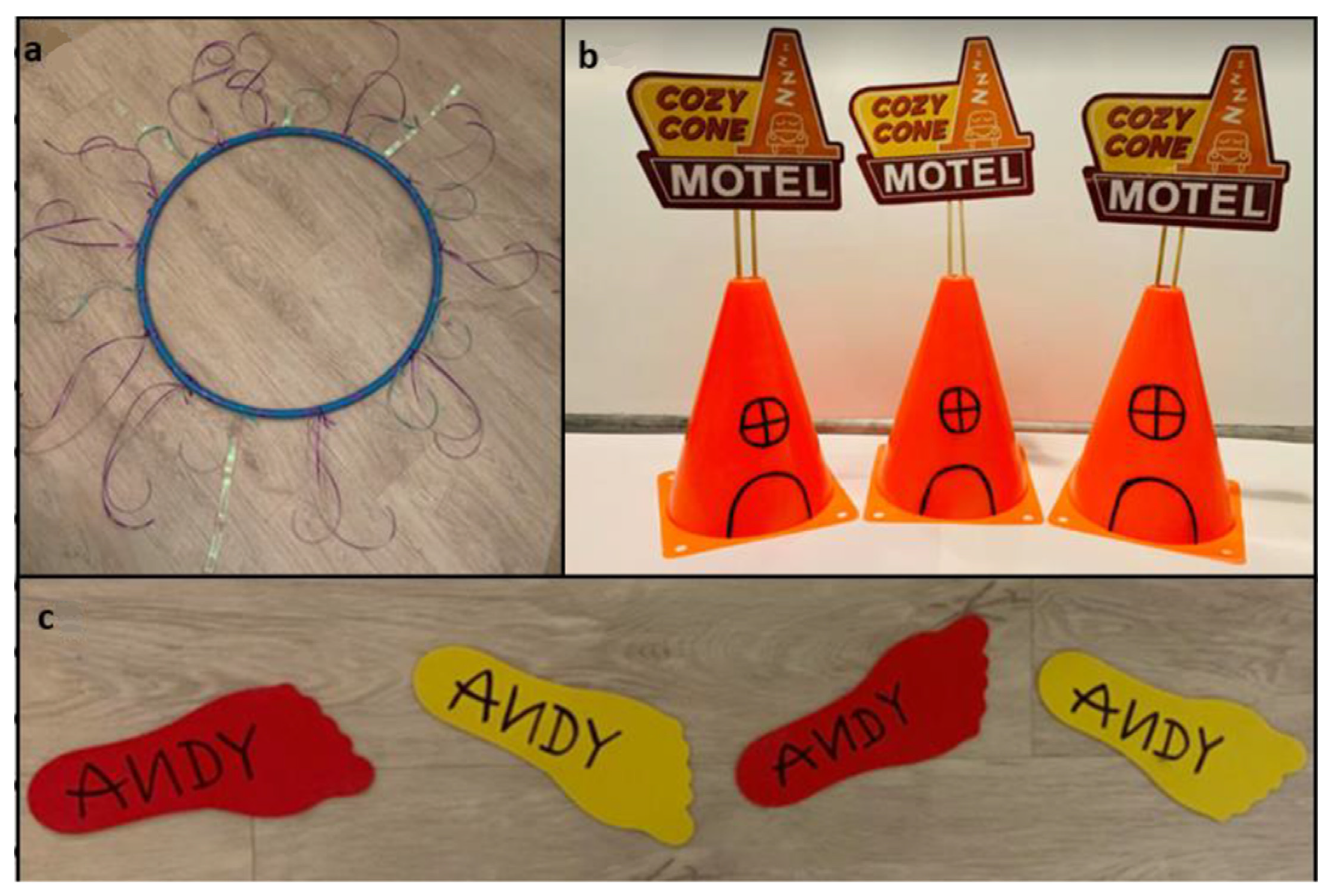
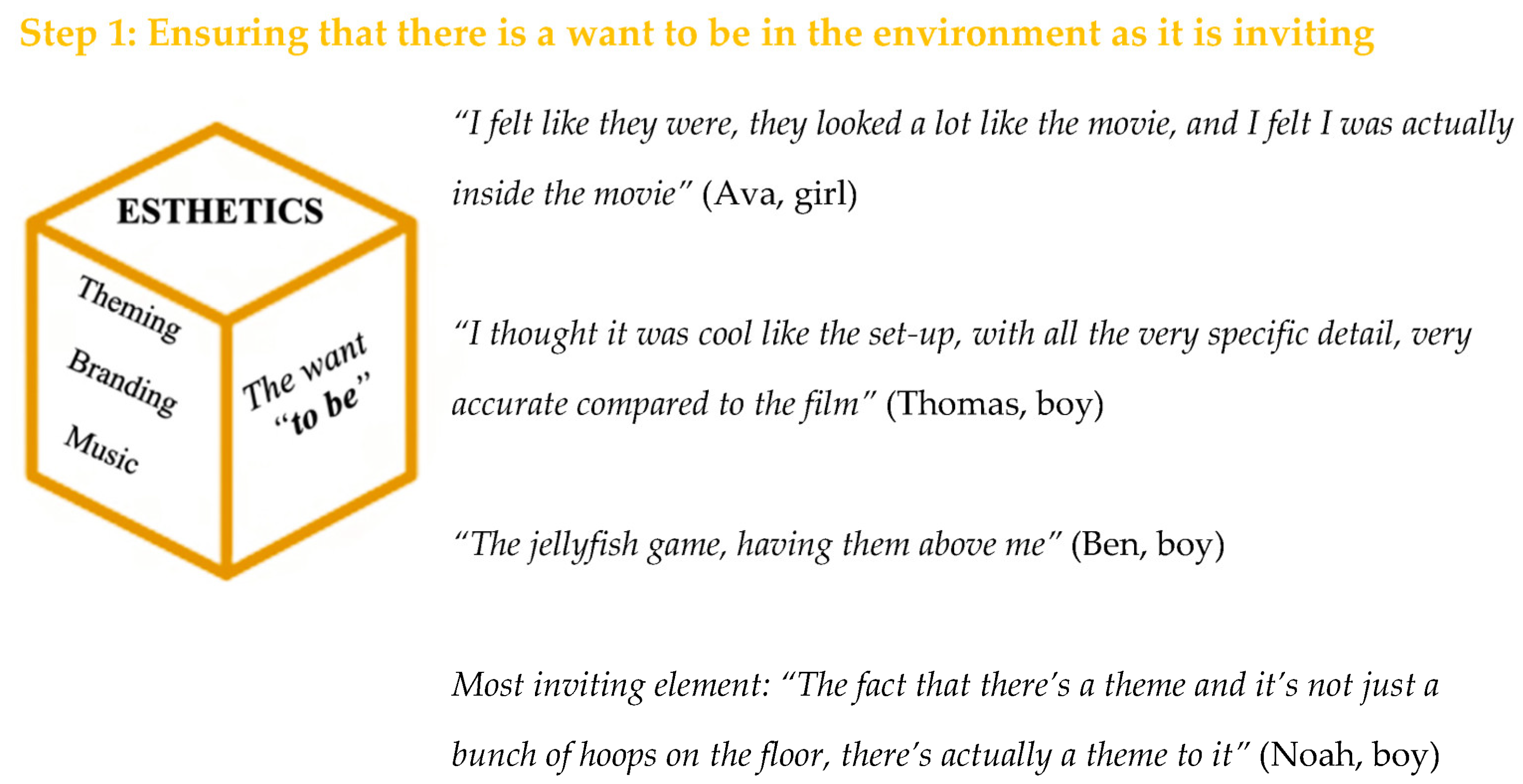
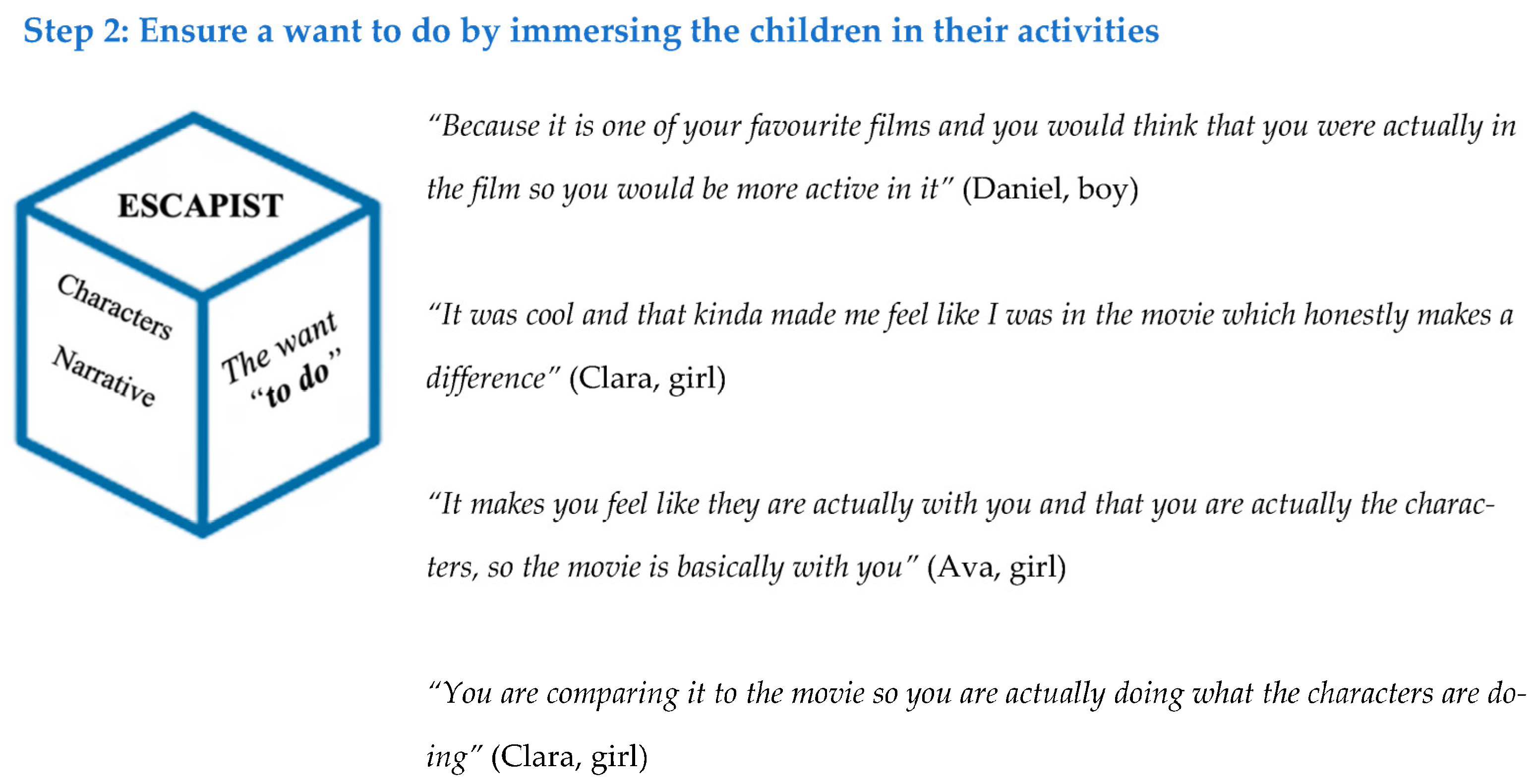
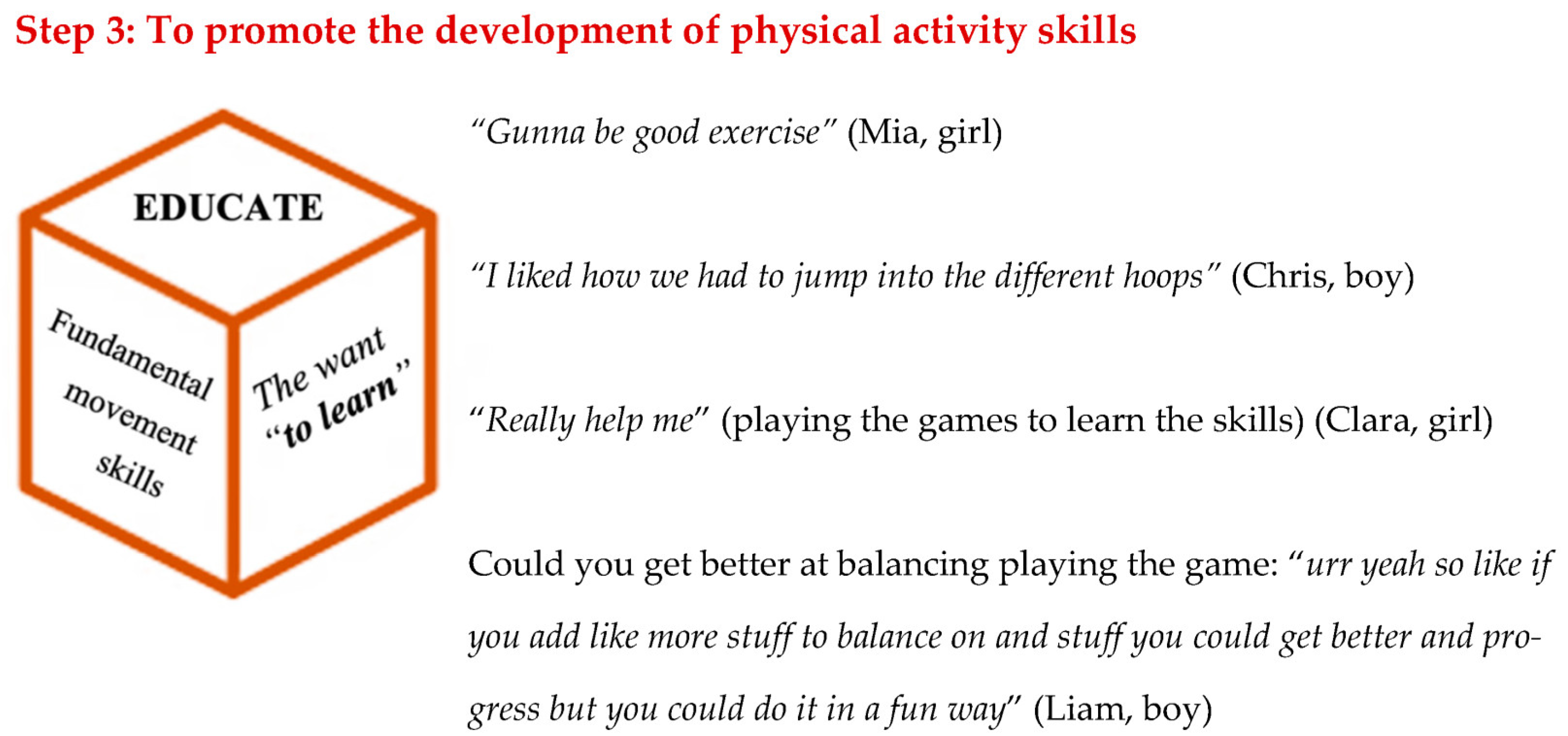

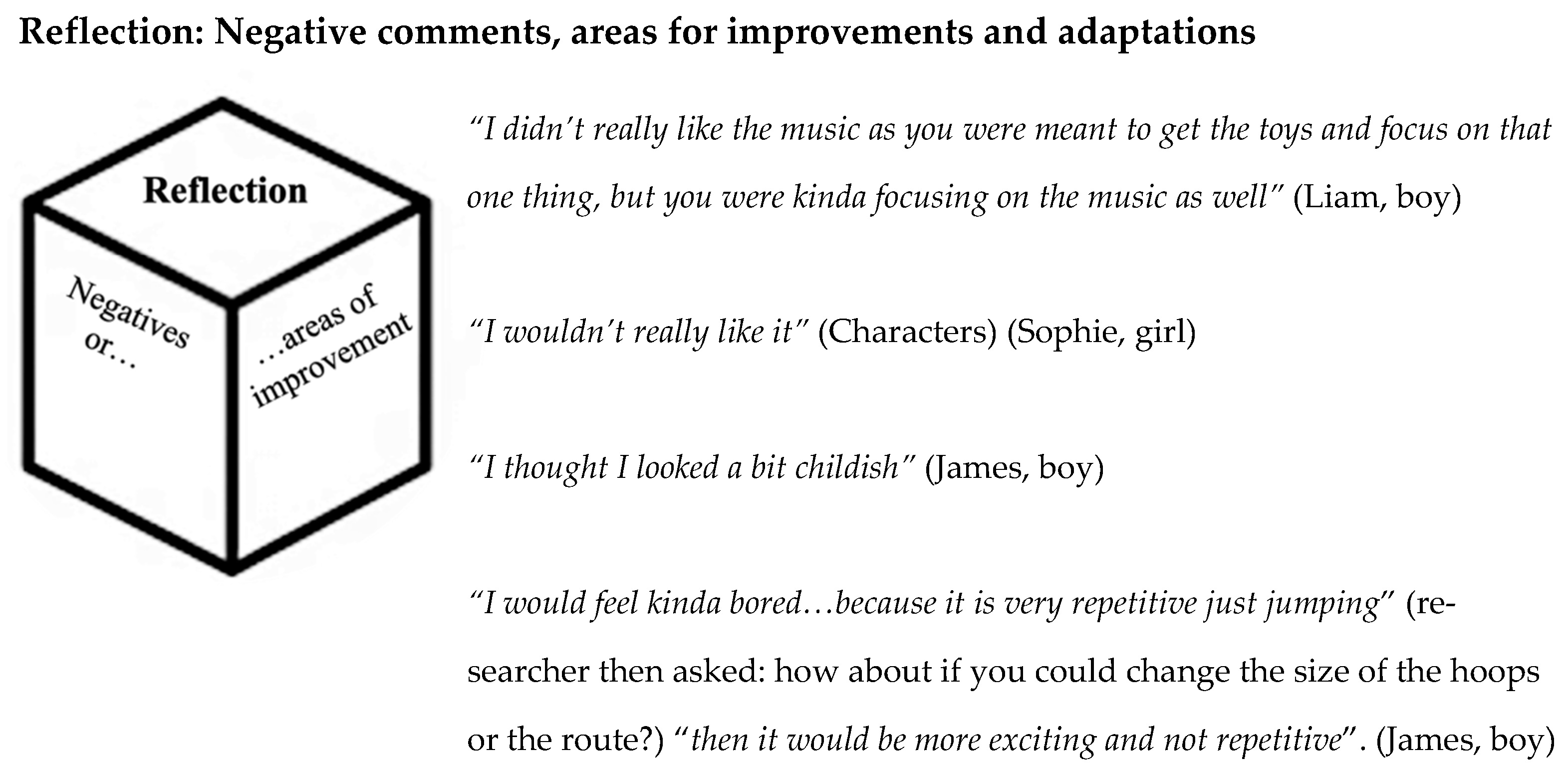
| (E) AESTHETICS: |
|
| ESCAPIST: |
|
| EDUCATE: |
|
| ENTERTAIN: |
|
Disclaimer/Publisher’s Note: The statements, opinions and data contained in all publications are solely those of the individual author(s) and contributor(s) and not of MDPI and/or the editor(s). MDPI and/or the editor(s) disclaim responsibility for any injury to people or property resulting from any ideas, methods, instructions or products referred to in the content. |
© 2023 by the authors. Licensee MDPI, Basel, Switzerland. This article is an open access article distributed under the terms and conditions of the Creative Commons Attribution (CC BY) license (https://creativecommons.org/licenses/by/4.0/).
Share and Cite
Budzynski-Seymour, E.; Jones, M.; Steele, J. “I Felt I Was Actually Inside the Movie” An Exploratory Study into Children’s Views of Staging a Physically Active Experience, with Implications for Future Interventions. Int. J. Environ. Res. Public Health 2023, 20, 3624. https://doi.org/10.3390/ijerph20043624
Budzynski-Seymour E, Jones M, Steele J. “I Felt I Was Actually Inside the Movie” An Exploratory Study into Children’s Views of Staging a Physically Active Experience, with Implications for Future Interventions. International Journal of Environmental Research and Public Health. 2023; 20(4):3624. https://doi.org/10.3390/ijerph20043624
Chicago/Turabian StyleBudzynski-Seymour, Emily, Michelle Jones, and James Steele. 2023. "“I Felt I Was Actually Inside the Movie” An Exploratory Study into Children’s Views of Staging a Physically Active Experience, with Implications for Future Interventions" International Journal of Environmental Research and Public Health 20, no. 4: 3624. https://doi.org/10.3390/ijerph20043624
APA StyleBudzynski-Seymour, E., Jones, M., & Steele, J. (2023). “I Felt I Was Actually Inside the Movie” An Exploratory Study into Children’s Views of Staging a Physically Active Experience, with Implications for Future Interventions. International Journal of Environmental Research and Public Health, 20(4), 3624. https://doi.org/10.3390/ijerph20043624






